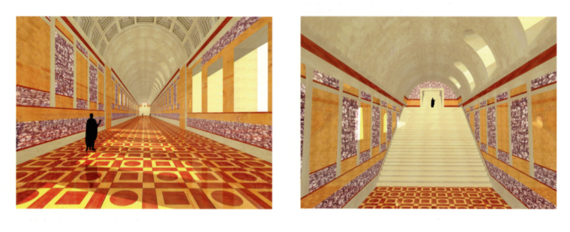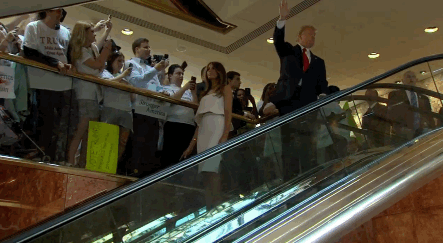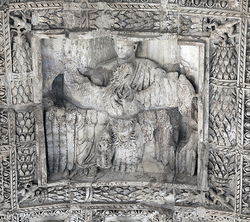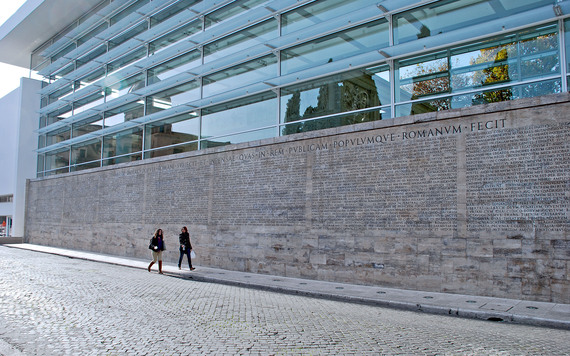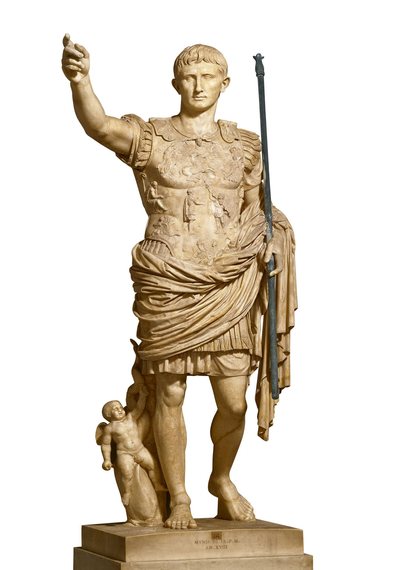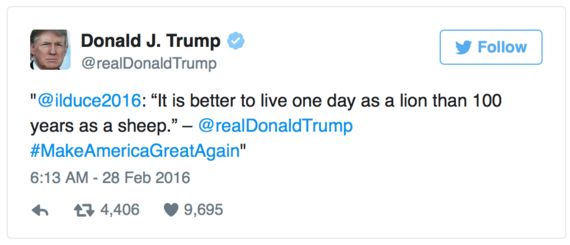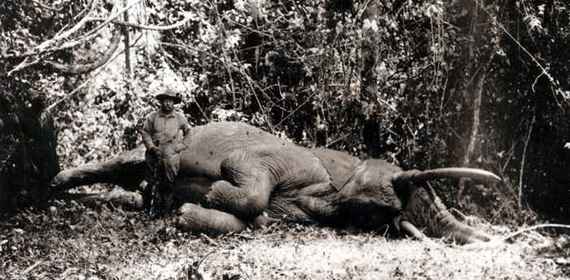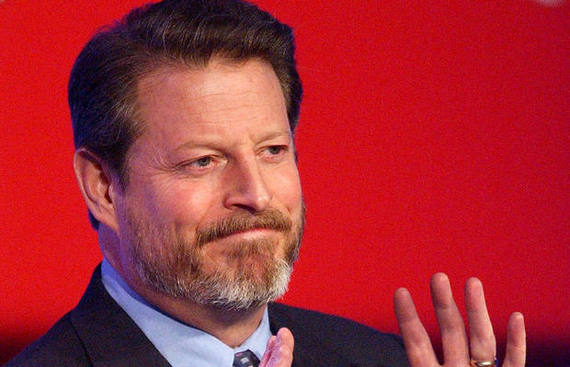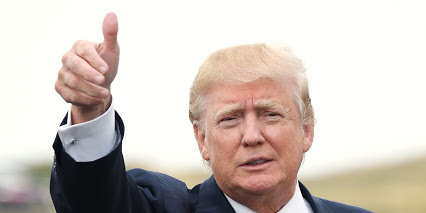Super Tuesday is a time for reflection on the successes and failures of each of the presidential campaigns. In a week that saw Hillary Clinton exceed all expectations in South Carolina and Donald J. Trump improbably weather an anemic denouncement of the KKK, it is clear that what these candidates represent symbolically, and their use of visual rhetoric, can be just as powerful and indelible as the things they say.
As a scholar specializing in the Roman Empire, it is difficult to watch the current election cycle and not detect certain resonances with leaders from antiquity -- specifically, the Roman emperors. This observation is not exclusive to one side of the aisle, although I must admit upfront that I have seen more pertinent examples from the Republican candidates (in particular, Trump) than the Democrats. Nonetheless, I offer the following as a reference guide for any presidential candidate on how to best emulate someone deserving of unquestioned and unmitigated power. In vaguely chronological order...
1.Create Drama
The Emperor Domitian (51-96 CE) built himself a summer villa called Castel Gandolfo in the Alban hills of Italy. If you had an audience with Domitian, you found yourself walking down a 300-meter long hallway, at the end of which was the Emperor, standing on a high staircase. The intention was to wow and to intimidate: Imagine listening to the sound of your feet echoing down this hallway as the supreme leader of the Empire, up on his perch, peers down at you.
Trump created a similar effect with his Trump Tower escalator when he announced his candidacy. Descending down from above, standing almost perfectly still, he created a scene that communicated wealth, power, and authority. Online people described this event as his "Grand Entrance." It was also parodied mercilessly (including by The Simpsons) for its grandiosity. But it is directly from the Roman Emperor Playbook where the word "tacky" does not apply. Well played, Trump.
2.Stage a Photo Op With an Eagle
One of the Flavian emperors, Titus (79-81 CE), depicted himself in the crown of the triumphal Arch of Titus riding up to the heavens on the wings of an eagle. This is referred to as his "apotheosis" -- Titus was depicting himself becoming a god.
While for different symbolic reasons, Trump also staged a photoshoot with an eagle. His results were less than deifying.
3. Pump Up Your Credentials
Trump famously declared after the Nevada GOP caucus that he and those who supported him were "winning, winning, winning the country" and that soon the "country is going to start winning, winning, winning." Similarly, the Roman emperors were not shy about heralding their "winning" far and wide. They erected monuments inscribed with their names and accomplishments (if you have ever been to Rome, think of the multiple triumphal columns, arches, statues, and buildings). Sound like any of our candidates? Overall, the idea was to promote how intimidating and successful the emperors were as leaders.
The reign of the emperor Augustus (27 BCE- 14 CE), for example, is a case study in how to execute effective PR. Augustus' reign was described as the Pax Romana ("The Roman Peace") and he approved and/or supervised a number of buildings projects to back up that claim. His entire Augustan funerary complex, for example, was aimed at communicating not only what an awesome military mind he was (he defeated Antony and Cleopatra and had obelisks imported to Rome to prove it), but to extoll his many virtues as the "first among equals." Incorporated into his complex was an altar to peace (the Ara Pacis) featuring bucolic images, idealized religious practices, and imperial processions aimed at celebrating his reign as divinely sanctioned. He also supervised the composition of something called the Res Gestae (the "things accomplished"), which was more or less his imperial résumé. It listed, among other things, all of the jobs that he had held, the awards he had won, the money he had donated, and the buildings he constructed. Again, sound like any of our candidates?
4.Build a Wall
Image Source: english-heritage.org.uk
Republican candidates continue to tout a wall on the U.S. border with Mexico. Trump's emphatic proposal in particular has earned comment both from former Mexican President Vicente Fox and the Pope.
The emperor Hadrian (117-138 CE) built a massive wall in Roman Britannia for reasons that remain somewhat fuzzy. Was it to keep out the so-called barbarians? Was it another demonstration of Rome's ability to communicate power through stone? We may never know for sure, but what we can say is that it was a symbolic shift in Rome's "foreign policy" to so forcefully delineate its borders.
For the record, Hadrian's Wall was abandoned shortly after his reign was over. And it's debatable whether it ever did much to secure the border it marked.
5.Align Yourself with "Greatness"
Image Source: nationalgeographic.com
In ancient Rome, it was common to align yourself with proven leaders from the past. Augustus claimed he had descended from the hero and founder of Rome, Aeneas, and his mother, Venus. And he made sure to boast these connections in his imperial imagery (see the cute little cupid riding a dolphin in his Prima Porta statue above).
The World War II Italian National Fascist Party dictator, Benito Mussolini, imagined himself a "New Augustus." He built a network of roadways to foreground ancient Roman ruins, like the buildings in the Imperial Fora and the Colosseum. He resurrected Augustus' Ara Pacis. And along the Via dei Fori Imperiali, he installed maps of the territories controlled by the Roman Empire, and added to these a map of the territory he himself had conquered.
Given Mussolini's alliance with Nazi Germany and Hitler, his military exploits, his associations with brutal intimidation tactics and rape, he is a surprising forbearer for any potential presidential candidate to claim. Yet, over the weekend, Trump re-Tweeted a Mussolini quote:
No doubt a rhetorical Twitter battle between Trump and Mussolini would be a thing to behold. Alas, history has deprived us of that experience.
But, thanks to the Internet, we have an idea of what a debate between the two might have looked like...
6.Alienate Your Opponents
The Roman historians Suetonius and Tacitus, among others, tell us that Roman emperors and the Roman Senate routinely expelled certain ethnic groups from the city. In the early first century CE, for example, evidence suggests ethnic Judeans (Jews) and ethnic Egyptians may have been driven from Rome for practicing certain religious activities considered outside of the mainstream.
Compare this with some of the rhetoric against Muslims in this campaign and promises to prevent members of this particular religious group from entering the United States. Purely symbolic at this stage, it is a proposal characteristic of emperors and empires.
7.Shoot Something
Image Source: theodore-roosevelt.com
There is a long tradition of politics and hunting. Teddy Roosevelt famously shot and stuffed anything that moved. In more recent memory, from John Kerry to Bill Clinton to George Bush, almost every single one of our presidential candidates have staged a hunting photo op and/or touted their guns on social media. And then, of course, in 2006 Vice President Dick Cheney, accidentally shot his friend, attorney Harry Whittington, in the face with birdshot.
Image Source: bluffton.edu
Turning to Rome, the emperor Commodus (177-192 CE) staged public hunts in the amphitheater, standing in a protected, elevated box and knocking off ostriches, bears, and lions with spears and arrows. Although arguably a symptom of his egomaniacal mental illness, he also liked to depict himself as the god Hercules, wearing a lion skin on his head. Paging Vladimir Putin?
Image Source: artofmanliness.com
The purpose of these displays is to emphasize the political leader's masculinity. They are performances that communicate strength and virility.
We have seen echoes of this strategy throughout the campaign to date. There was Jeb Bush's gun. Recall Trump claimed he could shoot someone and not lose voters.
This week, we also saw a back and forth between Trump and Marco Rubio that centered on claims to masculinity. Trump repeatedly referred to Rubio as "Little Marco Rubio." Rubio retorted by suggesting, as New York Magazine put it, "... Donald Trump Has Smaller Than Average Genitals." Shades of Drunk History.
8.Never Change
Image Source: sharpmagazine.com
We do not like our public figures to change or to make bold style choices. When Al Gore grew his "Just-Lost-the-Election" beard it was front-page news. And it did not go unnoticed when, after leaving their respective television shows, Jon Stewart and David Letterman grew what The New Yorker dubbed "The Achievement Beard." During the recent Wisconsin debate between Senator Sanders and former Secretary of State Clinton, Twitter was on fire with comments about Clinton's bold chartreuse jacket.
Roman emperors depicted themselves as larger than life, as gods, as orators, as Greek heroes, but never as truly subject to time. Consistency was key. When the emperor Augustus died, for example, he was 75 years old. Yet his statues very rarely depict him as older than middle-aged. Evidence of wrinkles, hair loss, changes in facial hair, or weight gain was rare in imperial depictions. There were, of course, exceptions (e.g., Marcus Aurelius and Vespasian are depicted as older men on occasion). But imperial statues were so precise, you could slightly alter Caligula's straight hairline into the more tousled look of Augustus and it would immediately change the identification of the figure.
(Images from author's files)
With the possible exception of Sanders, our candidates are also meticulously coiffed and groomed. Any rupture in the expected pattern garners comment. Remember the kerfuffle over Barack Obama's tan suit?
And I do not profess to understand how Trump styles his hair but, as best I can tell, the fundamental configuration has not changed since the 1980s. Whether a matter of function or fashion, he evidently understands the importance of consistency as a public figure. That's how Roman emperors roll.

